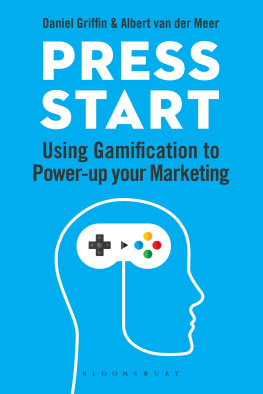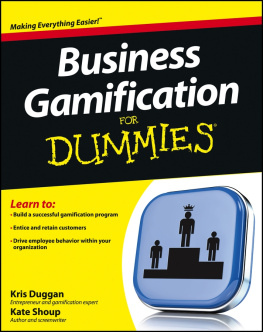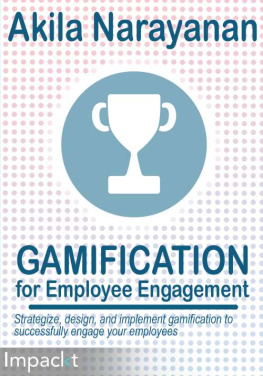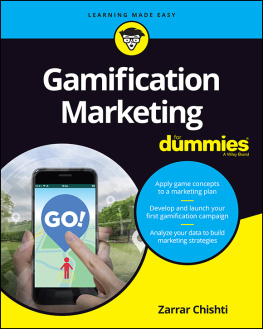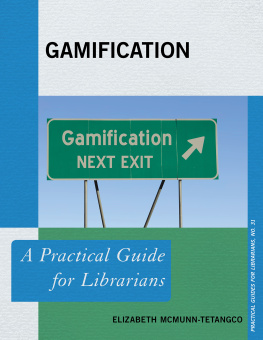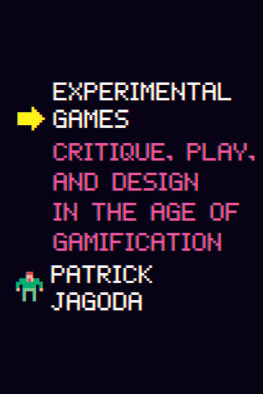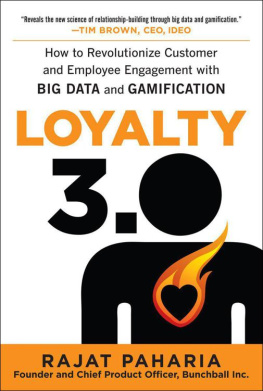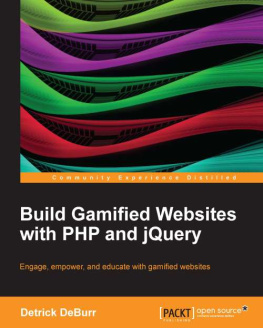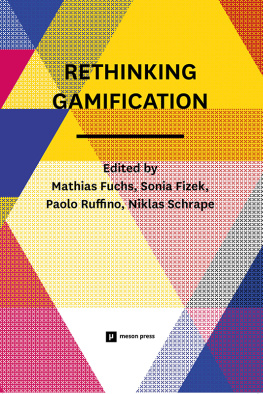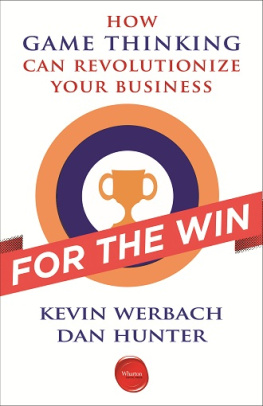Whether you are an experienced marketer or just starting out on your career, Press Start provides a useful overview of the fundamental principles of marketing from Maslows Hierarchy and the core motivational levers, to the modern complexity of human behaviour and a new tier of human needs. With tried and tested case studies, Press Start will set your goals and metrics, build a business case and develop your own marketing gamification strategy.
Sarah Sherwin, Managing Director, Broad Street Communications Ltd.
Marketing gamification is one of the best-kept business secrets of our times. Press Start is the insight-packed roadmap every marketer needs to unlock commercial rewards from gameplay in solving real-world customer problems.
Tony Wood, Managing Director, X Factor Communications and Co-founder, Virgin Money
Press Start provides thoughtful insight into the psychology of customer engagement, with a focus on how lessons from the world of games can generate ongoing customer loyalty. The book is a well-written, entertaining blueprint for marketers who would like to understand the opportunities of gamification, but also need to understand the pitfalls of bad game design. It is of particular relevance for marketers seeking to build on-going, multi-round, long-term relationships with their customers.
Professor Kai Peters, Pro-Vice-Chancellor of Business & Law, Coventry University
Fascinating. A must-read for anyone interested in applying gamification to marketing. I have been waiting for a book like this for a long time, and its finally here.
Jonah Berger, Associate Professor of Marketing, Wharton School of the University of Pennsylvania and author of Contagious: Why Things Catch On
Play has created strong communities since the dawn of mankind. This ground-breaking book elegantly builds upon philosopher Huizingas concept of purposeful play and seamlessly links it to neurobiological research, motivational theory and consumer behaviour. In this thoughtful and well-researched book, the authors have masterfully blended accessible theory with practical advice which will help the reader develop their own, detailed marketing gamification strategy.
Dr Albert Zandvoort, Professor, HEC Paris Business School, Psychotherapist and Entrepreneur
For anyone wanting to understand, apply and implement gamification when it comes to marketing, read this book. Dan and Albert leave no stone unturned, analysing motivation and psychological theories, providing real-life case studies, stories and principles, whilst providing you with a toolkit to design your own gamification solution to allow you to better connect with your clients and potential customers.
Simon Heyes, founder, Novel
For serious marketers only! If you are looking to integrate gamification into your marketing strategy, well, youve come to the right place. This is the bible. Finally a truly strategic approach to an often-times misunderstood practice.
Joe Pulizzi, author of various books including Killing Marketing, Content Inc . and Epic Content Marketing
Press Start is a particularly insightful book and easy read for anyone interested in game mechanics. Van der Meer and Griffin turn industry jargon into a practical and useful framework that can be applied to a multitude of business challenges right away.
Thomas Clever, Managing Director and Co-Founder, Clever Franke
Its easy to underestimate the power of games. However, challenges and rewards are effective tools for driving consumer loyalty and engagement. Press Start not only provides fascinating insights into this process, it also functions as an accessible and engaging guide to success.
Nir Eyal, bestselling author of Hooked and Indistractable
Press Start upends conventional thinking in marketing and goes a step further hacking directly into aspects of human motivation and psychology to provide a genuinely revolutionary path to customer connection. Gamification is a megatrend that will soon be a determining factor in the success of marketing firms, and this is the ur-text to kick-start your gamification strategy.
David Mayer, Leadership Partner in Data and Analytics, Gartner

Contents
Gamification .
Both of us have stood at the front of hundreds of workshops, meetings and various other audiences and uttered that one word. And we can usually guess the initial response.
Sometimes were lucky, and its one of genuine interest and enthusiasm. But often its a rolling of eyes, maybe even the cry of fad or the occasional smirk. These are the tell-tale signs of people who have tried and failed to implement one of the most powerful motivational tools we have available to us, or worse, a sign that they never tried at all and just dismissed it because of too many negative opinions around it.
We get it, weve either seen it, been part of it or thought the same thing too. Both of us have been interested in gamification since it gained its first burst of mainstream popularity around 2012. We were both working at a business school at the time, and as avid gamers, we were both initially excited by the possibility of merging our favourite pastime with our professions.
We followed the same bandwagon and tried and failed at various implementations across marketing, HR and L&D over the years. We did what a lot of other people did at the time, we read a few guides and case studies online and blindly applied gamification to everything we could with no structure or strategy:
Of course adding badges and points to our website will improve engagement
If we just add a forum to this teaching portal, our students will start talking to each other...
Maybe if we add a leaderboard this might work...
It was a new, shiny toy that we all just wanted to play with. And like all new, shiny toys, we got bored and moved on.
And gamification died, or at best, limped along, dragged by an army of consultants and experts who didnt want to lose their jobs or the industry niche theyd carved out for themselves.
Or at least thats what the majority of people think. The reality is that gamification never died; it just went undercover. This is especially true for our area of expertise, marketing gamification.
Points, badges, leaderboards these are the words you normally hear when anyone starts talking about marketing gamification, and thats usually when people stop listening. Theyve heard it before, didnt work for them then, wont work for them now.
But if we talk about eBay, Fitbit, LinkedIn, Duolingo or Booking.com and what tools and techniques these companies use to grow so successfully then people start listening again.
The truth is, gamification is alive and well in marketing, but the success stories arent apparent enough or have been rebranded as User Experience (UX) or Customer Experience (CX), as marketers try distancing themselves from a set of tools and techniques that people see as gimmicky or manipulative.
These marketers are customer focused; they have done the work to understand what their customers need from them and then looked for the best tools to engage with these customer needs. They found (either by accident or design) gamification.
The difference is that rather than blindly applying tools with no strategy, they started with strategy first, and then tested a wide range of tools to see what worked and what didnt. There were no gimmicks, no silly games, and no paint-by-numbers approaches. They worked out how to do this without a guide, just like us.

